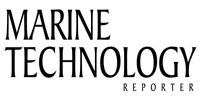
Page 25: of Marine Technology Magazine (July 2025)
Read this page in Pdf, Flash or Html5 edition of July 2025 Marine Technology Magazine
aunch and recovery are often the riskiest parts of a subsea operation, and as iDrop COO David Gal- braith points out, with a payload of new data, sub- sea vehicles are more valuable on recovery than
L they were on launch.
For iDrop, the challenge is how to launch and recover large numbers of its autonomous ocean bottom nodes (OBNs). The current method for laying OBNs, which catch re? ected waves during seismic surveys, involves specialist vessels and crews.
Instead, iDrop’s Oceanid drones are designed to self-steer to the sea? oor without the need for ROV help or DP-capable mother vessels. They can then resurface back into simpli? ed collection lines for easy recovery.
All launch and recovery systems (LARS) aim for ef? ciency, but with swarms, the challenges are ampli? ed. “We have all these bespoke launch and recovery solutions recovering our multi-million-dollar AUVs, but those solutions just don’t scale economically when you’re talking about a variety of dif- ferent vehicles, or swarms,” says Seth McCammon, a scientist at Woods Hole Oceanographic Institution. “A LARS sys- tem for a swarm needs to be ? exible and repeatable, since it will have to pick up many, and likely many different AUVs”
The solution, he says, is to have two types of vehicles: larger, more capable autonomous platforms that can recover smaller, less capable ones. The smaller swarm members need to be able to navigate underwater but not necessarily localize glob- ally underwater. They could just localize to where they last surfaced or descended.
The recovering autonomous surface vessel needs to be a much more capable platform, perhaps with machine vision as well as GPS and the ability to detect acoustic signals. “You’re investing more in the autonomous systems on that vehicle, but you need signi? cantly fewer of them,” he says. This lets the inexpensive AUVs bene? t from the extra capability of the sur- face vessel, while still keeping each AUV low-cost.
McCammon is currently developing a net system for an au-
KRAKEN ROBOTICS OFFERS THE
ISO20-LARS, WHICH FITS AN ISO20
FOOTPRINT (PICTURED), AND A
MORE COMPACT LARS SUITABLE FOR
UNCREWED SURFACE VESSELS.
Source Kraken Robotics
MTR #5 (18-33).indd 25 MTR #5 (18-33).indd 25 7/29/2025 1:08:47 PM7/29/2025 1:08:47 PM

 24
24

 26
26
